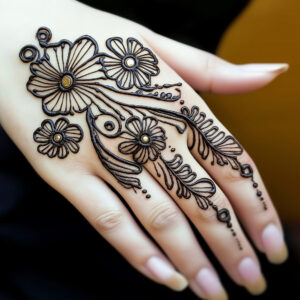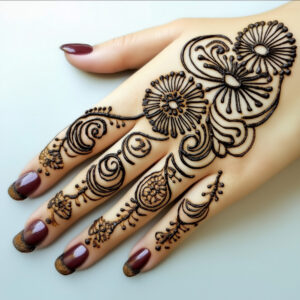Arabic Mehndi Design: Crafting Symmetry and Movement on Skin
As a sculptor, I’ve always been fascinated by the beauty in details—the way a small curve or an intricate line can bring life to stone or metal. So when I encountered Arabic Mehndi designs, it was like seeing my own art, but on a completely different medium: skin.
Arabic Mehndi, much like sculpture, focuses on clean lines, bold shapes, and a sense of rhythm that brings the design to life. It’s all about the contrast between simplicity and complexity—something I deeply appreciate in my own work. The floral patterns, the empty spaces, and the swirling vines remind me of the curves and cuts in marble or wood, where every stroke is deliberate and meaningful.
Arabic Mehndi: Carving Beauty with Precision
In the world of sculpture, precision is everything. A single misstep can alter the entire form, and the same goes for Arabic Mehndi. The designs are often free-flowing yet controlled, with bold outlines that stand out against the skin. What makes it different from other Mehndi styles is how it plays with space. Instead of filling every inch with intricate detail, Arabic Mehndi uses negative space to its advantage, creating a design that feels both airy and structured.
For a sculptor, this is like leaving parts of the stone uncarved, allowing the natural beauty of the material to speak for itself. The curves and lines in Arabic Mehndi mirror the way a chisel might carve out the details in a piece of wood or marble, leaving sections untouched to create a balance between fullness and emptiness.
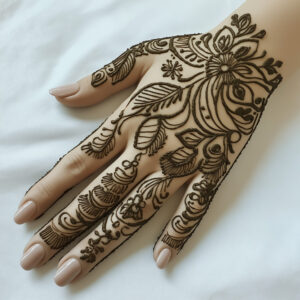
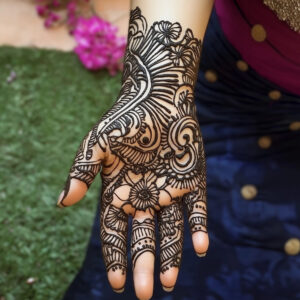
The Art of Movement in Mehndi
One thing that struck me while observing an Arabic Mehndi artist at work was the fluidity of their hand movements. It reminded me of the way a sculptor moves when chiseling a curve into stone—calm, steady, and intentional. Each line flows into the next, creating a continuous movement that feels almost alive.
Arabic Mehndi designs often feature long, flowing patterns that stretch across the hand and arm, much like the way a sculptor might shape a long curve in a statue. The way these patterns are laid out on the skin feels like a journey, guiding the eye from one part of the design to the next. In sculpture, we talk about guiding the viewer’s gaze, leading them to see the form in its entirety, and Mehndi does the same on a much smaller, more intimate scale.
Finding Balance: Symmetry in Mehndi and Sculpture
If there’s one thing that every artist—whether working with skin, stone, or metal—knows, it’s the importance of balance. In Arabic Mehndi, you’ll often find symmetry in the designs, much like the balance needed in a well-crafted sculpture. The placement of each vine, each flower, is deliberate, creating a harmony that’s both calming and visually engaging.
In my sculptures, symmetry isn’t always obvious at first glance, but it’s there. It’s in the way the shapes balance each other out, even if they aren’t perfectly mirrored. In Mehndi, especially Arabic styles, the same subtle balance exists. It might not be perfect symmetry, but the design still feels harmonious. The negative space balances out the bold patterns, creating a piece that feels complete without being overwhelming.
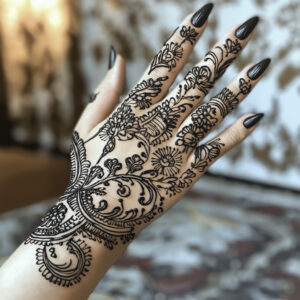
From Skin to Stone: Mehndi and the Sculptor’s Eye
The more I looked at Arabic Mehndi designs, the more I realized that the principles of this art form aren’t so different from sculpture. Whether you’re working with stone or skin, the goal is the same: to create something beautiful, balanced, and meaningful. The bold lines of Arabic Mehndi, the way it uses empty space, and the flow of the designs all echo the work I do in my studio.
What fascinates me most is how Mehndi artists manage to create something so detailed, yet temporary. In sculpture, we aim for permanence—stone lasts centuries, after all. But Mehndi? Mehndi is fleeting. And maybe that’s what makes it so special. There’s an urgency to it, a reminder that beauty doesn’t need to last forever to be appreciated.
Mehndi: Sculpting with a Different Medium
At the end of the day, I’ve come to see Arabic Mehndi as another form of sculpture—just on a different canvas. Instead of working with stone or metal, the artist works with skin. Instead of using a chisel, they use a henna cone. But the principles remain the same: precision, balance, and an eye for detail.
For anyone who loves art, whether you’re a sculptor, painter, or just an admirer, Arabic Mehndi offers a unique blend of simplicity and complexity that’s hard not to appreciate. It’s an art form that, like sculpture, takes time, patience, and a steady hand to master. And while the designs might fade, the impact they leave behind is lasting.

